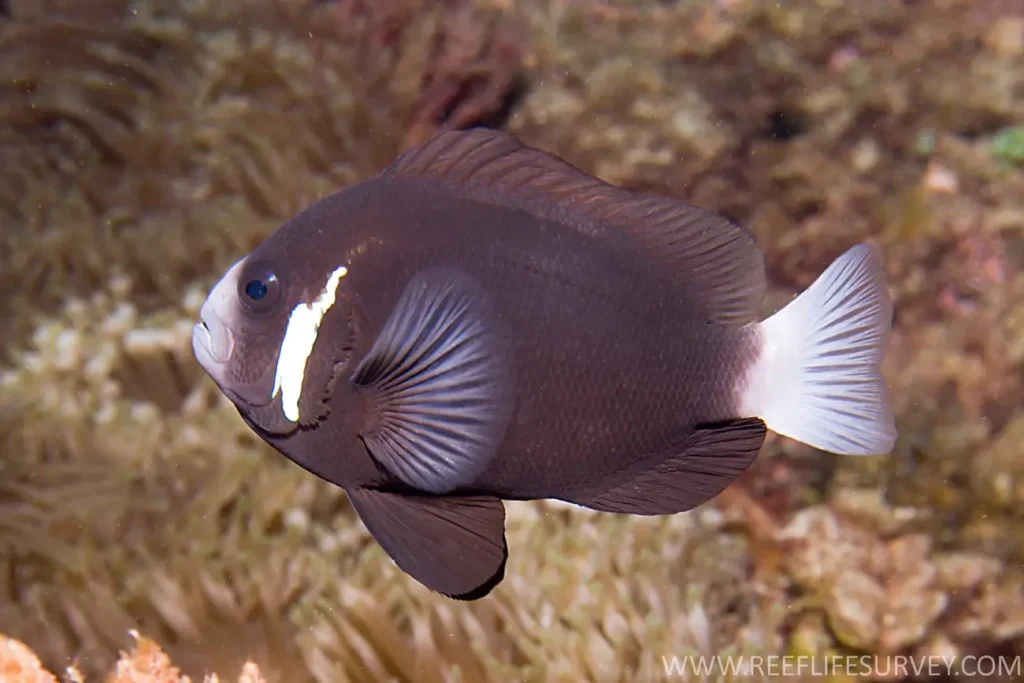Among the numerous species of clownfish, a special place is occupied by MacCulloch's clown (Amphiprion mccullochi) - a rare, endemic species that lives only in one part of the world. Unlike most of its relatives, which have bright red-orange tones, this species is noted dark, almost black color, with one white stripe behind the eye.
✔ Lives exclusively off Lord Gau Island, Australia
✔ It belongs to the group of "twilight" clownfish due to its dark color
✔ Enters into a symbiosis with large sea anemones
✔ One of the rarest species in the wild
Because of its limited habitat and rarity, this species is of particular importance to scientists and aquarists.

Scientific classification
✔ The Kingdom: Animals (Animalia)
✔ Type: Chordal (Chordata)
✔ Class: Lucheperi pisces (Actinopterygii)
✔ Row: Perch-like (Perciformes)
✔ Family: Pomacentrovye (Pomacentridae)
✔ Gender: Amphiprions (Amphiprion)
✔ View: Amphiprion mccullochi
✔ Open: 1929 by James Douglas Ogilby
Habitat and habitat
🌎 Endemic to Lord Gau Island (Australia) - this species is not found anywhere else in the world!
🌊 It lives among coral reefs in shallow waters (5-15 meters).
🏝 Prefers sheltered lagoons with sea anemones
This species is extremely limited in its distribution, making it vulnerable to changes in its habitat.
Appearance and coloring
🔸 Body color: Dark brown or almost black
🔸 Lanes: One white vertical stripe behind the eyes
🔸 Size: Adults grow to 12-14 cm
🔸 Swimmers: Dark, sometimes with a slight brown or yellowish tinge
This coloration helps them blend in with the shadows of the reef and anemone, providing natural protection from predators.
Lifestyle and behavior
✅ Symbiosis with anemones: A. mccullochi mostly lives in partnership with anemone Entacmaea quadricolor (bubble anemone).
✅ High territoriality: It defends its anemone very aggressively against other fish, including other clowns.
✅ Colony structure: The group has dominant female, a smaller male and several young individuals who can change sex if necessary.
As with all clownfish, when a female dies, the largest male changes sex and becomes a new female.
Food
🔹 An omnivorous species, consuming:
✔ Zooplankton
✔ Small crustaceans
✔ Seaweed
✔ Organic anemone remains
Thanks to the symbiotic relationship with the anemone A. mccullochi receives access to leftovers and protection from predators.
Reproduction
🔹 Proteroginal hermaphrodite - males can change gender to females
🔹 Caviar is deposited at the base of the anemone
🔹 The male takes care of the caviar and cleans it of detritus
🔹 After 6-8 days, the larvae hatch and are carried by the current until they settle to the bottom
Enemies and threats
🔸 Predatory fish (moray eels, barracudas, groupers, perches) preying on young people
🔸 Climate change threatened by the destruction of coral reefs, which are the main habitat of this species.
🔸 Human activity - habitat destruction, fishing for aquariums
Due to its small population and limited range the species is particularly vulnerable and needs protection.

Role in nature and popularity
✔ An important symbiotic partner for anemones
✔ A rare but valuable species for aquariums
✔ It is of great importance for research on the adaptation of clownfish
Although A. mccullochi not the most popular among marine aquarists due to its rarity, it is valued for unique color scheme and behavioral features.
Interesting facts
🔹 There one of the most restricted types of clowns in the world
Despite its dark color, it adapts relatively easily to life in captivity
, Interacts only with one species of anemone is Entacmaea quadricolor
💥 There is always a female the largest fish in the colony
Conclusion
McCulloch's Clown (Amphiprion mccullochi)- this is a rare and unique representative of clownfish, which lives only in one point of the planet. Its dark coloration, symbiotic relationship with the anemone, and interesting hierarchical structure make it a special find for scientists and divers.
📢 Protecting coral reefs and minimizing human impact on their habitat is the key to preserving this unique species! 🌊🐠💙